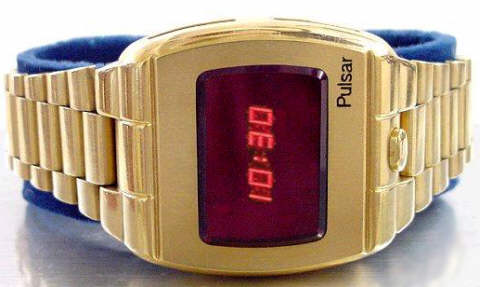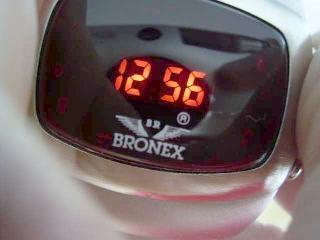LED
The L.E.D. watch - the first ever electronic wristwatch with digital display based on advanced Light Emitting Diode technology. An interesting animated explanation can be found here by Juergen Hofstaedter from Germany.
The first digital electronic "solid state" watch ("no moving parts") was a result of longterm research made parallely by various inventors at the end of the 1960's with the boom of micro-computer technology. Not only was it a challenge to miniaturize all the revolutionary circuitry into a wristwatch case but additionally competing teams couldn't make up their mind as to which display technology to choose as the most optimal in terms of readout and battery consumption. Honestly speaking there were already some ideas for a digital watch on the drawing boards but technology was behind with creating a small reliable display format. Nixie lamps and VFD's must have been considered but they were either to big and/or power-hungry. The watch industry focused on LED technology and LCD (based on liquid crystals) that were invented a few years before but still a reliable micro-display source was not available for commercial use until 1971.

Depending on the display of choice several independent project teams continued their efforts with huge input from leading micro-electronics companies. Most of these brands don't ring a bell to anybody but credit must go to RCA which developed a reliable electronic circuit, Hewlett-Packard or Litronix which developed a reliable LED display. The LED watch would not be possible without cooperation and competition in the micro-electronics industry. Many patents were granted but only a few teams succeeded with a marketable product of which the first was the one and only... Pulsar Time Computer Inc. (Pulsar in short).
It all started in 1969 with two forgotten engineers: George Thiess and Willy Crabtree from Electro-Data (Garland, Texas) who worked on a miniaturized LED watch circuitry. They were approached by John M. Bergey an engineer at Hamilton Watch Company who lead a project team working on a solid state digital wristwatch. At that time Hamilton company already has a few patents pending on a solid state watch of which one was filed by Richard S. Walton in April 1969 under reference #3576099... shortly after Hewlett Packard launched the first LED display the HP5082-7000 Solid State Numeric Indicator. However Electro-Data must have been farther ahead in their research so in result Bergey's team subcontracted the development to Electro-Data and their combined efforts and ideas finally made it possible to file a patent #3672155 and present a prototype in May 1970...using the above mentioned HP5082-7000 LED displays. Surprisingly neither Thiess nor Crabtree are credited in the patents! Unfortunately as there was more marketing than reliable technology in the faulty prototypes it took another 2 years to present a marketable product when the first Pulsar LED "P1" was launched on April 4th 1972. By that time Electro-Data went bankrupt whereas the Hamilton Watch Company formally ceased to exist as a legal entity. Due to financial problems the greatest American watch manufacturer was restructured to form HMW Industries and Hamilton remained as a label only that was sold to the Swiss giant SSIH (today Swatch Group). Luckily the digital watch unit of the former Hamilton company was transformed into a new spin-off company Time Computer Inc. which was now solely responsible for producing and marketing Pulsar LED watches. Nevertheless the solid-gold P1 cases that were ordered upfront still had the Hamilton insignia inscribed on the caseback. The Swiss with their Hamilton brand gained quick access to the LED technology and benefited from marketing Omega Time Computer as the first LED watch in Europe in 1973. Pulsar continued supplying both Hamilton and Omega watches with their inhouse magnet-set P2 and P3 modules until approx. 1975 when the SSIH group subcontracted LED modules (1602/1603) to Frontier USA.

"The Pulsar P1" was offered for $2100 in a limited edition of 400 pieces in 18 kt. solid gold (as pictured below) and sold out in a blitz by various celebrities around the world including the Shah of Iran. The price was outstanding and worth a car (Chevrolet Vega). Due to enormous power consumption the LED display was turned off most of the time and only lit up to show time by means of pressing a (magnetic) button on the case. Nevertheless Electro-Datas circuitry with 25 individual chips proved to be a big failure and most of the first model watches had to be withdrawn from the market and refitted with a parallely developed and robust inhouse Pulsar module 2800 (found also in early "P2" models). This "disaster" ended the cooperation between both companies with all the credit taken by Hamilton/Pulsar. Today only LED enthusiasts value the input of Electro-Data which has greatly influenced the early years of LED development. Nearly all original E-D modules were recalled and destroyed but occasionally a few of them reappear on eBay and reach +500$ in nonworking condition. Moreover once in a decade a lucky collector grabs a solid gold P1 or a nickel-silver test/demo version with the original 25 chip module and so far less than a handful have been found in working condition :)
The P1 still remains the most desirable electronic wristwatch ever made, especially that only 10% of the initial production quantity is known to exist. Many have been melted in 1980 when gold prices reached records and this trend continues among people that are not sentimental with family treasures and prefer to earn a quick buck. Just a few years back there were 27 P1's among collectors but as of today this number has reached approx. 40 and a few more will be found in the near future. Pulsar P1 prices fluctuate depending on the value of solid gold or market trends in the Watch World. Usually a perfect condition P1 with all boxes, magnet and papers will reach 10-15.000$, used but working pieces without any extras range from 5000-8000$ and nonworking P1's reach only scrap value of approx. 3000-4000$.
With the introduction of the P1 the race for the first digital watch was won by the LED however research continued within the LCD technology. Energy efficient LCD's slowly pushed the power-hungry LED out of the field and made it completely obsolete at the end of the 1970's when Pulsar decided to close down without changing to LCD technology (the one and only LCD from Pulsar was subcontracted to Japan). All other major producers changed to LCD in 1978 while the Pulsar name (not company) was sold to Seiko which today is successfully marketing their watches as Pulsars mostly on the American market.
Despite the prehistoric LED technology it is difficult today to fully appreciate the know-how cased in the Pulsar spacedesign wristwatch as we all are acustomed to digital technology and displays. If one should compare the breakthrough technology of the Pulsar Time Computer in todays values the only thing that comes to mind would be the first personal computer (PC) or todays mobile phones that revolutionized communication.
The Pulsar Time Computer is honestly "The watch that changed the way we tell time". Nobody before would ever say that it is "12:08" - rather "8 minutes past 12". Most of the displays used everywhere today are digital therefore the Pulsar LED watch can be thought of as one of the breakthroughs in the technology of the XXth century. Roger Riehl should also be credited for inventing the first solar-powered LED watch called Synchronar with solar panels on top of the case (solar-charged button cells would be more precise). Riehl had working prototypes already in 1971 but patents were approved only in 1974. There was a large dispute on who was first in the LED community but no matter how you look at it Pulsar was the first to successfully market a reliable mass-scale product. If not for the huge Hamilton financing perhaps history would be much different.
With the end of the previous millenium we have encountered an uprise of the forgotten LED technology. More and more watch designs are being fitted with LED technology although the feel and quality of these modern imitations is not even close to the vintage originals. Even some LCD's are being made as LED "look-a-likes" by using black LCD displays that are lit red from behind (as shown below).
One way or another it is very satisfying, that the old and forgotten retro LED is back!!!


